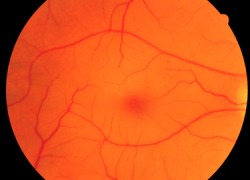Signs and Symptoms

Symptoms appear around 3-6 months of age due to brain damage and nerve cells form build up of fatty compounds. an early sign of Tay-Sachs is a red dot on the retina.
Symtoms at 3 to 6 months old
Decreased eye contact.Twitchy eyes.Difficulty focusing on objects.Excessive startling by sharp but not necessarily loud noises
At 6 to 10 months, you may notice:
Limp and floppy muscles.Decreased alertness and playfulness.Difficulty sitting up or rolling over and a loss of motor skills.Decreased hearing and eventual deafness.Gradual loss of vision.An abnormal increase in head size.
10 months and older
As a child with Tay-Sachs grows older, he or she may become blind, mentally retarded, paralyzed, and unresponsive to the environment. The child also may have seizures, difficulty swallowing, and difficulty breathing. Children with Tay-Sachs disease rarely live beyond 4 or 5 years of age.
Late-onset Tay-Sachs disease
Symptoms of late-onset Tay-Sachs disease (LOTS) usually develop between adolescence and the mid-30s. The symptoms vary among individuals, depending on the amount of hex A being produced by the body. At first, symptoms such as clumsiness or mood changes are subtle and may go unnoticed. Other symptoms that may develop include:Personality changes.Muscle weakness or twitching. Slurred speech.Impaired thinking and reasoning ability, such as memory problems, difficulty with comprehension, and short attention span.
Inability to distinguish between what's real and unreal (psychotic episodes) or depression.
